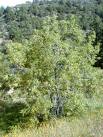Arizona Black Walnut Tree Information
Images of Arizona Black Walnut:






Arizona Black Walnut grows in the following 5 states and provinces:
Arizona, Colorado, Maine, New Mexico, TexasInformation about Arizona Black Walnut:
The Juglans Major is commonly known as the Arizona Black Walnut, Arizona Walnut as well as Nogal.
The currently accepted scientific name of Arizona walnut is Juglans major (Torr.) Heller. It is a member of the walnut family (Juglandaceae) . Two varieties are currently recognized: J. m. var. major J. m. var. stewartii M. Johnst. . Arizona walnut hybridizes with Juglans microcarpa Berl. in the Trans-Pecos region of Texas .The range of Arizona walnut extends from central Texas westward to southwestern New Mexico and central Arizona . Its distribution continues southward into northern Mexico, where it is found from eastern Sonora to western Coahuila . Several authors reported that Arizona walnut was found in Colorado; however, Harrington stated that no specimens had been found to support this range extension.Arizona walnut occurs in pure or mixed stands or as scattered individuals. It is dominant or codominant in the southwestern or interior deciduous broad-leaved habitat series with Arizona sycamore (Platanus wrightii), Fremont cottonwood (Populus fremontii), velvet ash (Fraxinus velutina), and western soapberry (Sapindus saponaria var. drummondii) . Arizona walnut is an indicator species in the mixed conifer series in ponderosa pine (Pinus ponderosa), white fir (Abies concolor), Douglas-fir (Pseudotsuga menziesii), and quaking aspen (Populus tremuloides) habitat types . Additionally, in southwestern oak woodlands or chaparral, Arizona walnut is seral throughout the Emory oak (Quercus emoryi) series and is a minor component of Gambel oak (Quercus gambelii) community type . Some of the publications that list Arizona walnut as a dominant or indicator species include: (1) Classification of riparian vegetation (2) Classification of mixed broadleaf riparian forest in Tonto National Forest (3) A forest habitat type classification of southern Arizona and its relationship to forests of the Sierra Madre Occidental of Mexico (4) Classification of riparian habitat in the Southwest (5) Riparian forest and scrubland community types of Arizona and New Mexico . Species associated with Arizona walnut that were not previously mentioned in Distribution and Occurrence information are canyon grape (Vitis arizonica), deergrass (Muhlenbergia rigens), and common hoarhound (Marrubium vulgare) .Some of the information provided here is attributed to:Pavek, Diane S. 1993. Juglans major. In: Fire Effects Information System, [Online]. U.S. Department of Agriculture, Forest Service, Rocky Mountain Research Station, Fire Sciences Laboratory (Producer). , available at the USDA Fire Effects Information System (FEIS) website